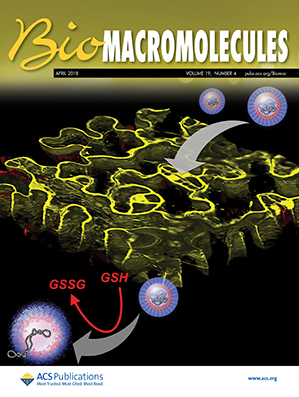Compositional Control of Stereocomplexed Hydrogel Microparticle Network Formation and Physical Properties
IF 5.4
2区 化学
Q1 BIOCHEMISTRY & MOLECULAR BIOLOGY
引用次数: 0
Abstract
Granular hydrogel scaffolds composed of many discrete hydrogel microparticles (HMPs) have demonstrated significant advantages over bulk hydrogels, including injectability and the flexibility to incorporate diverse chemistries, physical properties, and bioactive payloads. Herein, we demonstrate the ability to tune HMP properties through varying the length of poly(ethylene glycol) (PEG) arms and stereocomplexed poly(lactic acid) (SC PLA) cross-links within PEG-based HMPs to further understand the networks’ structure–property relationships and utility in a model prodrug delivery system. DSC and WAXS revealed that hydrogels with shorter PEG arms were able to form stereocomplex domains to a greater extent than longer PEG arms. Additionally, as the SC PLA length increased, the HMPs were more thermally and mechanically stable. HMPs were also loaded with model prodrug, doxorubicin, to characterize compositional variations’ effects on release profiles. These studies suggest that variations in the cross-linker concentration influence the crystallinity of each HMP formulation, allowing for tunable drug loading and release.
- Download: Download high-res image (203KB)
- Download: Download full-size image
立体络合水凝胶微粒网络形成及物理性质的组成控制。
由许多离散的水凝胶微粒(HMPs)组成的颗粒状水凝胶支架与散装水凝胶相比具有显著的优势,包括可注射性和结合不同化学、物理性质和生物活性有效载荷的灵活性。在此,我们展示了通过改变聚乙二醇(PEG)臂和立体络合聚乳酸(SC PLA)交联在聚乙二醇基HMP中的长度来调整HMP性质的能力,以进一步了解网络的结构-性质关系和在模型药物前递送系统中的效用。DSC和WAXS显示,短PEG臂的水凝胶比长PEG臂的水凝胶更能形成立体配合物结构域。此外,随着SC PLA长度的增加,hmp的热稳定性和机械稳定性更高。HMPs还装载了模型前药阿霉素,以表征成分变化对释放曲线的影响。这些研究表明,交联剂浓度的变化会影响每种HMP制剂的结晶度,从而可以调节药物的装载和释放。
本文章由计算机程序翻译,如有差异,请以英文原文为准。
求助全文
约1分钟内获得全文
求助全文
来源期刊

Biomacromolecules
化学-高分子科学
CiteScore
10.60
自引率
4.80%
发文量
417
审稿时长
1.6 months
期刊介绍:
Biomacromolecules is a leading forum for the dissemination of cutting-edge research at the interface of polymer science and biology. Submissions to Biomacromolecules should contain strong elements of innovation in terms of macromolecular design, synthesis and characterization, or in the application of polymer materials to biology and medicine.
Topics covered by Biomacromolecules include, but are not exclusively limited to: sustainable polymers, polymers based on natural and renewable resources, degradable polymers, polymer conjugates, polymeric drugs, polymers in biocatalysis, biomacromolecular assembly, biomimetic polymers, polymer-biomineral hybrids, biomimetic-polymer processing, polymer recycling, bioactive polymer surfaces, original polymer design for biomedical applications such as immunotherapy, drug delivery, gene delivery, antimicrobial applications, diagnostic imaging and biosensing, polymers in tissue engineering and regenerative medicine, polymeric scaffolds and hydrogels for cell culture and delivery.
 求助内容:
求助内容: 应助结果提醒方式:
应助结果提醒方式:


